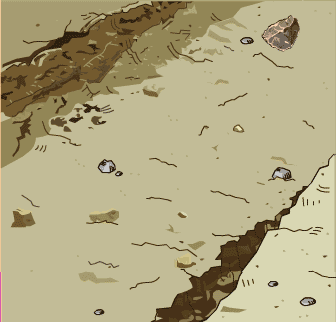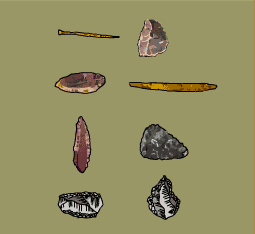|
 |
 |
|
Site 1

About this Site
This is an open-air site in northern France. It is located 400 meters from a slow-moving river on a terrace 40 meters above the river's current water level.
The exposed layer has been linked temporally to a layer found in surrounding sites. Dating experts have determined that objects at these other sites are 300,000 years old. This layer is comprised of fine sediment.
Dig
You used your brush to remove a layer of gravel to expose six stone artifacts.

Deduce
You found six stone tool artifacts and two bone fragments within a thin layer of sediment. The bone fragments belonged to Bos, wild cattle abundant in Neanderthal times. Previous excavations have uncovered many similar tools and bone fragments within this layer. Many of the bone fragments have markings made by stone—apparently stone tools.
If we can demonstrate that this layer is a "living floor"—a layer of sediment that was at one time exposed and occupied, was later covered, and has remained undisturbed ever since—then we'll have strong evidence that the tool-using hominids consumed wild cattle at this site and probably hunted them, too. The presence and positions of bone, tools, etc. from a living floor can also reveal insight into the behavior of the inhabitants.
The fine sediment and the concentration of artifacts in a thin layer could lead you, the expert, to believe that this is indeed an example of a living floor and therefore that the hominids lived here and ate the animal Bos.
But what if you were to take a closer look at the orientation of the artifacts and bone fragments? The objects pictured to the right are oriented just as they were when you first found them. Notice how they are pointing either up/down or right/left. Other tools and bone fragments found in this layer line up the same way. It is extremely unlikely that any human would have gone to the effort to place these pieces so precisely. Water running over these artifacts and bone, however, could cause such alignments.
So, here is an indication that water washed over the pieces, which also means that they were most likely deposited by the water. This is strong evidence, then, that this layer is not a living floor.
But, even if this layer is not a living floor, there's still the evidence of marks on the bone. So we can still safely assume that the hominids ate Bos, right?
As you may have guessed, there's another explanation for how the marks could have appeared on the bone fragments.
The streambed here contains flint gravel, which has sharp edges. The bone fragments you found may well have come in contact with this gravel as the water carried them downstream. The gravel could have caused scratches in the bone. And what if an animal stepped on a bone as it moved over a sharp flint edge? An even deeper mark would have resulted. It is possible to distinguish between naturally occurring marks and those made by a human, but it turns out that there are not enough specimens here to make that assessment. So we cannot say with certainty that the hominid who lived during this time ate Bos, at least not based on the evidence found at this site.
Final Note
This example is based loosely on an excavation that took place at the site of Cagny-L'Epinette, located in the Department of Somme, France. For many years some of the sediment layers at this site were believed to be examples of living floors. This assumption was challenged in 1997 when archeologists provided evidence similar to that given here.
If you haven't already done so, there is more digging and deducing to be done at Site 2 and Site 3.
Casts of Characters |
Into the Fray |
Tracing Ancestry with MtDNA |
Dig and Deduce
Resources |
Teacher's Guide |
Transcript |
Site Map |
Neanderthals on Trial Home
Search |
Site Map |
Previously Featured |
Schedule |
Feedback |
Teachers |
Shop
Join Us/E-Mail |
About NOVA |
Editor's Picks |
Watch NOVAs online |
To print
PBS Online |
NOVA Online |
WGBH
© | Updated November 2001
|
|
|
|